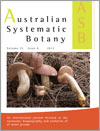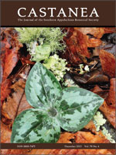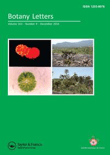
Boletin de la Sociedad Argentina de Botanica
Scope & Guideline
Connecting researchers through the lens of Latin American botany.
Introduction
Aims and Scopes
- Plant Diversity and Taxonomy:
The journal publishes research on the identification, classification, and documentation of plant species, particularly focusing on native flora and new species discoveries. - Ecological Studies and Conservation:
Research addressing ecological dynamics, conservation strategies, and the impact of human activities on plant communities, including studies on invasive species and habitat restoration. - Ethnobotany and Cultural Practices:
Exploration of the relationships between local communities and plant species, including traditional uses, medicinal applications, and the cultural significance of plants. - Physiological and Morphological Research:
Studies investigating the physiological traits, anatomical structures, and adaptive strategies of plants in various environments, contributing to a deeper understanding of plant biology. - Agricultural Botany and Crop Genetics:
Research on agricultural plant species, focusing on genetics, cultivation practices, and the role of native species in agroecosystems.
Trending and Emerging
- Climate Change Impact on Flora:
Recent publications increasingly address the effects of climate change on plant distributions, phenology, and ecosystem dynamics, underscoring the urgency of understanding these impacts for conservation efforts. - Urban Ecology and Green Spaces:
There is a growing focus on the role of urban environments in supporting plant diversity, with studies examining the integration of native species in urban planning and their ecological benefits. - Restoration Ecology:
Research on ecological restoration, particularly involving native species and agroecosystems, is gaining momentum as a response to habitat loss and degradation. - Ethnobotanical Knowledge and Food Security:
With a rising interest in food sovereignty and traditional ecological knowledge, studies exploring the role of native plants in local diets and cultural practices are becoming more prominent. - Functional and Morphological Plant Research:
Emerging trends include detailed studies on plant functional traits and their morphological adaptations, contributing to a better understanding of plant resilience and ecological roles.
Declining or Waning
- Invasive Species Management:
Although previously a significant area of research, studies specifically targeting the management of invasive species have decreased, possibly as the community shifts towards broader ecological impacts and interactions. - Historical Botany and Taxonomic History:
Research focusing on the historical aspects of botany, including the taxonomic history of certain plant families, appears to be waning, indicating a potential shift towards more contemporary ecological and conservation issues. - Plant Pathology Studies:
With an increasing emphasis on ecological and conservation research, dedicated studies on plant pathology, particularly those focusing on specific pathogens, have become less frequent.
Similar Journals

Botany
Unveiling the mysteries of botanical systems.Botany is a premier academic journal published by Canadian Science Publishing, dedicated to advancing the understanding of plant sciences and ecological systems. With an ISSN of 1916-2790 and an E-ISSN of 1916-2804, this journal has established itself as a respected publication in the fields of Ecology, Evolution, Behavior and Systematics, and Plant Science, reflected in its 2023 Q2 and Q3 rankings. Covering a wide range of topics, Botany is committed to fostering interdisciplinary research, promoting innovative methodologies, and disseminating significant findings from both theoretical and applied perspectives. Based in Ottawa, Canada, the journal is open access, ensuring that high-quality research is accessible to a global audience, thereby playing a crucial role in the dissemination of knowledge in the scientific community. With convergence years from 2008 to 2024, it continues to evolve alongside the scientific advancements in botanical studies, making it an essential resource for researchers, professionals, and students alike.

AUSTRALIAN SYSTEMATIC BOTANY
Charting the Future of Australian Plant ResearchAustralian Systematic Botany is a prestigious academic journal dedicated to the field of plant science, published by CSIRO PUBLISHING. Established in 1988, this journal has become a vital resource for researchers, professionals, and students focusing on the systematic study of Australian flora. With an impressive track record and convergence extending to 2024, it operates in the Q3 category for Ecology, Evolution, Behavior and Systematics and Q2 for Plant Science as of 2023. The journal holds significant value in the academic community, given its Scopus ranking, which places it in the 61st and 59th percentiles within its respective categories. Although it follows a subscription-based model, the journal remains committed to advancing knowledge in systematic botany, offering critical insights that shape the future of ecological and biological research both in Australia and globally.

INTERNATIONAL JOURNAL OF PLANT SCIENCES
Exploring the frontiers of plant science and ecology.The INTERNATIONAL JOURNAL OF PLANT SCIENCES, published by UNIV CHICAGO PRESS, is a leading journal dedicated to advancing knowledge in the fields of plant sciences and ecology. With an ISSN of 1058-5893 and an E-ISSN of 1537-5315, this journal has been a prominent platform for groundbreaking research since its establishment, featuring works from 1983 to present. It holds an impressive Q2 ranking in both Ecology, Evolution, Behavior and Systematics and Plant Science, reflecting its reputable standing within the academic community. The journal is well-regarded for its rigorous peer-review process and commitment to high-quality publication standards, making it a favored choice for researchers, students, and professionals eager to engage with the latest findings and innovative methodologies in plant research. While it does not currently operate under an Open Access model, the journal provides ample access options for institutions and individuals keen to explore its curated content. By presenting diverse studies that blend theoretical and practical insights, the INTERNATIONAL JOURNAL OF PLANT SCIENCES plays a critical role in fostering interdisciplinary dialogue and advancing the frontiers of plant science research.

CASTANEA
Cultivating a Deeper Understanding of Our Natural WorldCASTANEA is a distinguished journal published by the SOUTHERN APPALACHIAN BOTANICAL SOCIETY in affiliation with NEWBERRY COLLEGE. With an ISSN of 0008-7475 and an E-ISSN of 1938-4386, this esteemed publication serves as a vital platform for researchers and practitioners in the field of Plant Science. It has been circulating since 1982, and its scope focuses on the study of trees, their ecology, and conservation, thereby contributing significant insights into the biodiversity of the Southern Appalachian region and beyond. Despite its current ranking in the Q4 quartile and the 5th percentile in the Scopus Agricultural and Biological Sciences category, CASTANEA is committed to advancing knowledge and fostering a deeper understanding of plant sciences among academics and students alike. The journal does not currently offer Open Access options, maintaining a traditional subscription model that allows for carefully curated and peer-reviewed content. As you explore the advances in plant biology through CASTANEA, you will find an invaluable resource that supports both emerging and established scholars in their research endeavors.

Alpine Botany
Unveiling the Secrets of Alpine Biodiversity.Alpine Botany is a premier scholarly journal published by SPRINGER BASEL AG, dedicated to the field of ecological and botanical research with a specific focus on alpine environments. With an ISSN of 1664-2201 and an E-ISSN of 1664-221X, this journal has established itself as a significant platform for disseminating high-quality research findings, with its latest category rankings placing it in the Q1 quartile for both Ecology, Evolution, Behavior and Systematics as well as Plant Science. Originating from Switzerland, Alpine Botany benefits from its geographical context, fostering a rich exchange of ideas and research advancements relevant to high-altitude flora. The journal operates under an Open Access model, promoting widespread accessibility of its content while accommodating an increasing demand for interdisciplinary studies within the ecological and botanical communities. With a commitment to excellence, Alpine Botany continues to serve as an invaluable resource for researchers, professionals, and students who are keen to explore and understand the complexities of alpine ecosystems.

Modern Phytomorphology
Fostering Discussions on Plant DevelopmentModern Phytomorphology is a distinguished open-access journal dedicated to the field of plant morphology and development, published by the renowned State Natural History Museum NAS Ukraine. Since its inception in 2012, the journal has become a vital platform for researchers and professionals to share innovative findings and engaged discussions surrounding phytomorphological studies. With the aim of furthering knowledge in plant form and structure, Modern Phytomorphology encourages submissions that explore the intricate relationships between plant morphology and environmental factors, evolutionary processes, and biodiversity. By providing an accessible medium for high-quality research, this journal significantly contributes to the scientific understanding of plant life, making it an essential resource for students, researchers, and educators alike. For those passionate about the intricacies of plant development, Modern Phytomorphology offers a rich repository of information that is both impactful and relevant in today's ecological context.

Mediterranean Botany
Advancing Knowledge in Plant Science and EcologyMediterranean Botany is a distinguished peer-reviewed journal dedicated to the flourishing fields of Ecology, Plant Science, and Ecology, Evolution, Behavior and Systematics. Published by the Universidad Complutense de Madrid, Servicio Publicaciones, this Open Access journal has been disseminating valuable research since 2018, ensuring that findings are accessible to a global audience, with an emphasis on Mediterranean vegetation and biodiversity. With an ISSN of 2603-9109, it contributes significantly to the academic discourse in its category quartiles, recently featuring in Q3 for Ecology and related fields. Notably, Mediterranean Botany ranks within the top half of its category in Scopus, highlighting its relevance and contribution to the scientific community. Researchers, professionals, and students alike will find the journal to be a vital resource for latest discoveries, trends, and conservation strategies in Mediterranean ecosystems, positioning it as an essential platform for advancing knowledge and fostering collaboration within the plant sciences.

PRESLIA
Innovating Conservation Through Research ExcellencePRESLIA, published by the Czech Botanical Society, is an esteemed academic journal that has been contributing to the fields of Ecology and Plant Science since its inception in 1979. With an impressive Q1 ranking in both categories for 2023, it stands out among its peers as a vital resource for researchers, professionals, and students alike. The journal is dedicated to disseminating high-quality research that advances our understanding of botanical sciences, encompassing a diverse array of topics from plant ecology to conservation strategies. With a ranking of #110 out of 516 in Plant Science and #103 out of 461 in Ecology on Scopus, PRESLIA consistently maintains a high impact, reflecting its crucial role in shaping contemporary scientific discourse. While traditional access options are available, the journal's commitment to fostering academic collaboration makes it a key player in the global scientific community. Located in Prague, Czech Republic, PRESLIA continues to bridge gaps in research and offers a platform for innovative scholarly communication up until 2024 and beyond.

Botany Letters
Exploring New Frontiers in Botany for a Sustainable FutureBotany Letters, published by Taylor & Francis Ltd, is a prominent journal in the field of Plant Science based in the United Kingdom. With its ISSN 2381-8107 and E-ISSN 2381-8115, the journal has established itself as an essential resource for researchers, professionals, and students alike, focusing on innovative studies and findings in botany. As a Q2 ranked journal in its category (2023) and holding a respectable Scopus rank of #200 out of 516 in Agricultural and Biological Sciences, it reflects a robust commitment to quality and relevance in the field. The journal's open access model ensures that groundbreaking research is readily accessible, fostering collaboration and knowledge sharing among the global scientific community. Covering a broad spectrum of topics within plant science from 2016, Botany Letters aims to catalyze advancements in the understanding and management of plant biodiversity and sustainability, ultimately contributing to conservation efforts and agricultural innovation.

JOURNAL OF AQUATIC PLANT MANAGEMENT
Exploring sustainable solutions for aquatic plant challenges.JOURNAL OF AQUATIC PLANT MANAGEMENT is a key scholarly publication focusing on the management and ecological aspects of aquatic plant species. Published by the Aquatic Plant Management Society, Inc, this journal serves as an essential resource for researchers, practitioners, and policymakers involved in aquatic ecology, environmental science, and plant management. Although it does not offer open access, it remains influential in its peer-reviewed contributions to the field. Covering a broad spectrum of topics related to the management of aquatic plants, the journal has established its presence in significant academic databases and is well-regarded in areas such as Agricultural and Biological Sciences and Environmental Science. Despite facing challenges reflected in its Scopus rankings, which position it within the lower percentiles for various categories, the journal continues to strive towards enhancing our understanding of aquatic systems and the interplay of plant species therein. With its inception dating back to 1979, the journal underscores the long-term commitment to advancing knowledge in aquatic plant management.